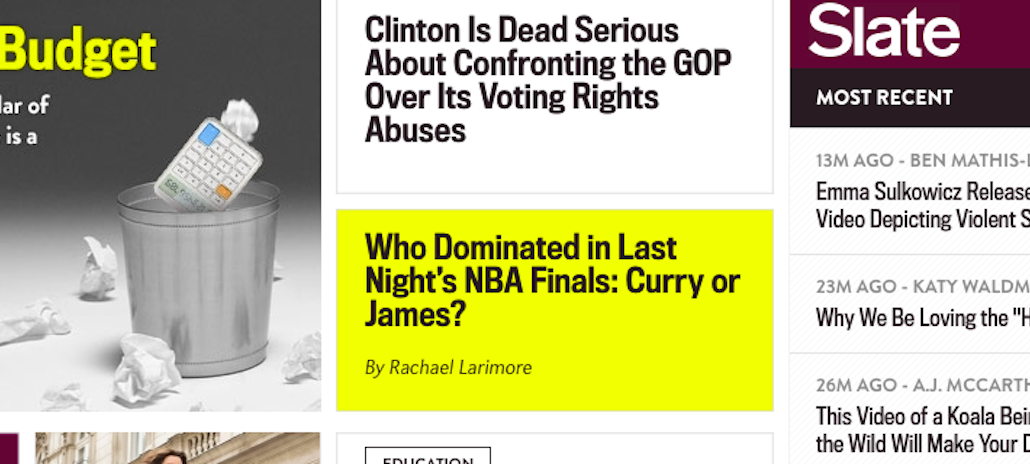Connect with execs from The New York Times, TIME, Dotdash Meredith and many more

For Slate, getting readers to pay for content was going back to the future. Back in 1998, it was one of the first sites to try a paywall, which quickly failed. Sixteen years later, the politics and culture site introduced Slate Plus, a membership model — don’t call it a paywall, please — that kept the site free but offered its most loyal readers additional benefits for $5 a month or $50 a year.
The draw: members of Slate Plus get ad-free podcasts; members-only stories and newsletters; early access to big stories; and discounts to live events. A year in, the numbers are solid if unspectacular: Slate said it has gotten more than 9,000 members, which, it said, has exceeded expectations. Still, the numbers aren’t eye-opening, representing an annual revenue intake of about $500,000. Slate is private and doesn’t release financials, but that’s undoubtedly a small part of its operation.
Julia Turner, Slate’s editor, said the publisher is seeking to grow that number 75 percent in year two, having seen sign-ups increase after a recent membership push and addition of new content. At that rate, membership revenue would near $1 million, a not unsubstantial sum.
“We launched Slate Plus because we were looking to diversify our revenue, and we knew we had a dedicated core of readers,” she said. “The fact we’ve seen a doubled weekly sign-up rate is a great testament to the product going forward.”
Nine thousand might seem like a tiny number. Assuming all are paying the annual rate (Slate said that 75 percent are), that’s $450,000 a year in Slate’s coffers. On the cost side, the program requires two full-time dedicated staffers, with a third to be hired soon, and existing staff.
But it’s early days. Many publishers have adopted paid-content strategies, but most are still in a period of testing and learning what portion of their audiences will pay for content, and how much. So direct comparisons with Slate are hard to come by.
“It’s an excellent start,” said Gene Hoffman, chairman and CEO of Vindicia, a subscription-billing service. “The fact they’ve got an existing subscriber base — which is probably a good percentage of their core audience. Are they making a huge amount of money yet? No, but they’re not aggressive about putting it out there.”
It’s almost impossible to generalize about which segment of a publisher’s audience will pay and how much they’re willing to fork over, because it depends so much on the price and the offering, said Trevor Kaufman, president and CEO of paywall operator TinyPass, which has Slate as a client.
“Everyone wants to know what percentage of my audience will become a paid subscriber,” Kaufman said. “The reason it’s not that simple is, sites vary tremendously in their loyalty. You can have a ton of traffic around Kim Kardashian articles, and a very small percentage are willing to pay.”
Kaufman said that 5-15 percent of his clients’ audience usually falls into the definition of dedicated audience. To come up with that figure, the company looks at metrics including the percent of a site’s audience that has visited it three or more out of the past 30 days and have seen eight or more pageviews in the past 30 days. From there, the target is usually to convert one-third of the dedicated audience to paying users. But that’s over time and refers to paywalls, which isn’t the Slate model.
The Slate Plus program is aimed at a small audience by design. The experience of a hard or metered paywall like The Wall Street Journal or The New York Times, two of the most famous paywall examples, doesn’t really apply. In those cases, people are cut off from content if they don’t subscribe, so you would expect a relatively high rate of sign-ups. At The Times, for example, which has a metered paywall, core digital subscribers represent about half its total paid circulation.
Slate kept its existing site free, though, so you would expect the uptake to be lower. Its approach is closer to that taken by The Guardian last September, where it kept the site free but gave people the chance to pay for discounts and access to events, £15 ($22) or £60 ($91) a month, depending on the level of membership. (The Guardian wouldn’t say how many paying members it has.)
The thinking at Slate is that getting those loyal readers to pay will not only generate revenue to fund more journalism but will foster a stronger connection to those readers who can be advocates for the publisher. It’s a strategy that runs directly counter to the scale chasing that has become common at many digital publishers today — and has given rise to extreme traffic measures that are of questionable value to advertisers.
“There’s incredible pressure to show growth in unique users which means attracting people to the site that have never been there before,” Turner said. “If sites aren’t careful, they can neglect the interests of their most loyal readers. We are an ad-supported business and expect to remain that way, but finding a way to connect with our core audience that will allow us to do things that are editorially innovative is what’s most exciting about Slate Plus.”
Slate has also used the past year to learn which benefits were most popular as it considers how to make the program stronger in year two. It saw that podcasts and behind-the-scenes articles and insights from individual writers did especially well, so it added some bonus podcasts. But people didn’t love hearing the promo language at the beginning of the podcasts, so Slate axed that. Also less popular was a new commenting technology that was debuted on Slate Plus that lets people chime in at any given part of an article.
Based on that feedback, Slate hopes to grow memberships by broadening its appeal with new content. A big component of this will be access to a new offering, Slate Academy, a collection of podcasts and articles that go deep into a subject area. The first, launched three weeks ago, focuses on the history of slavery in America. Other, still to-be-decided topics, will follow.
“People are happy with it as a product, and they respond particularly to content,” Turner said. “So the strategy for the second year is to do more of the stuff they like already and use Slate Plus as a lab to experiment with different types of products.”
Image courtesy of Slate.
More in Media

YouTube’s AI slop crackdown has creators concerned, marketers cheering
Despite the potential crackdown, both creators and marketers broadly view YouTube’s updated policies as a positive move. They believe it indicates that the platform is paying attention to the ways creators are using AI — and that it’s open to AI tools that don’t result in the propagation of so-called “AI slop” videos.

Jargon buster: The key terms to know on AI bot traffic and monetization
Here’s a breakdown of the emerging vocabulary of AI-media economics, what these terms mean, and why they matter now.

Digiday+ Research: Publishers identify the top trends among Gen Z readers
Gen Z makes up a very small percentage of publishers’ readership, but those Gen Z audience members are consuming their news anytime, anywhere.





